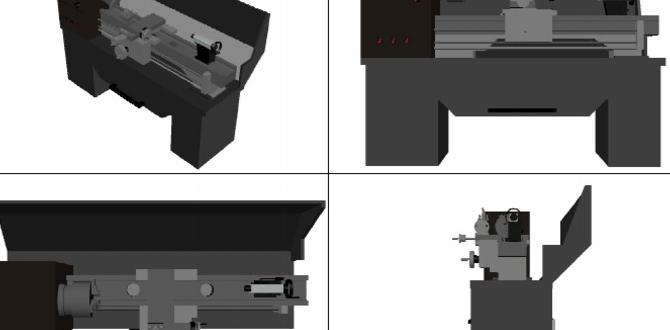Bolded Quick Summary:
A 3/16 inch carbide end mill with an 8mm shank is essential for cutting polycarbonate effectively. These mills offer the precision and heat resistance needed to make clean cuts, prevent melting, and achieve smooth finishes on this tricky material, making them a go-to tool for machinists working with polycarbonate plastics.
Working with polycarbonate can be a bit like wrestling a slippery, melt-prone champion. It’s a fantastic material for DIY projects, offering incredible strength and clarity, but cutting it cleanly can feel like a magic trick gone wrong. Too much heat, and you’re left with a gooey, deformed mess. Too much force, and you might chip or crack it. This is where the right tools become your best friends. Today, we’re diving into why a specific type of cutting tool – the 3/16 inch carbide end mill with an 8mm shank – is an absolute game-changer for polycarbonate. We’ll break down exactly what makes it so special and how you can start using it to get those perfect, crisp cuts you’ve been dreaming of.
The Polycarbonate Puzzle: Why Standard Bits Struggle
Polycarbonate, often known by brands like Lexan or Makrolon, is a thermoplastic. This means it softens significantly and can even melt when heated. When you try to cut it with standard tooling, especially at high speeds or with dull bits, a few undesirable things can happen:
- Melting: The friction generated by the cutting tool heats the polycarbonate beyond its melting point. This causes chips to weld themselves back onto the material and the cutter flute, creating a messy, unusable edge.
- Chipping and Cracking: If the material isn’t supported well or the forces are too high, brittle fractures can occur, leading to chips and cracks along the cut line. This is especially common with thinner polycarbonate sheets.
- Poor Surface Finish: Even if you avoid melting or chipping, you might end up with a rough, fuzzy edge that requires a lot of post-processing.
These issues are frustrating because they can ruin a project before it even gets going. It’s like trying to slice a tomato with a butter knife – you might get through it, but it’s not going to be pretty. For best results, you need tools designed to handle plastics with these specific properties.
Introducing the Hero: Carbide End Mill 3/16 Inch 8mm Shank
So, what makes the 3/16 inch carbide end mill with an 8mm shank the star player for polycarbonate? Let’s break down its key features:
Why Carbide?
Carbide, specifically tungsten carbide, is a super-hard material that’s significantly harder and more wear-resistant than high-speed steel (HSS). Here’s why that matters for polycarbonate:
- Heat Resistance: Carbide can withstand much higher temperatures than HSS without losing its hardness. This is crucial because cutting polycarbonate generates heat. A carbide tool stays sharp and effective even when things get a little warm, reducing the risk of melting.
- Edge Retention: Because it’s so hard, carbide holds a sharp edge for much longer. A sharp edge cuts more cleanly and requires less force, both critical for preventing melting and chipping in plastics.
- Machinability: While tough, carbide is also brittle. This means it needs to be manufactured with precision and handled carefully, but for machining applications where hardness is paramount, it’s the top choice.
The 3/16 Inch Diameter
The 3/16 inch (approximately 4.76mm) diameter is a sweet spot for many polycarbonate projects. It’s:
- Versatile: It’s large enough for efficient material removal on moderate cuts but small enough for intricate details and smaller projects.
- Precise: This size allows for good control and accuracy, which is important when working with a material that can be prone to deflection.
- Common: It’s a widely available size, making it easy to find the right tool for your milling machine.
The 8mm Shank
The shank is the part of the end mill that fits into your machine’s collet or tool holder. An 8mm shank (approximately 0.315 inches) is a common metric size found on many milling machines, especially those popular in Europe and for CNC hobbyist machines. Having the correct shank size is vital for:
- Secure Clamping: Ensures the tool is held firmly and won’t slip during operation. A slipping tool is dangerous and will ruin your workpiece and the tool.
- Vibration Reduction: A well-matched shank size contributes to a more stable cutting process, reducing vibrations that can lead to poor surface finish and tool breakage.
- Compatibility: Makes sure the tool fits your existing collet set without needing adapters, simplifying your setup.
Long Reach vs. Standard Reach
When looking for end mills for polycarbonate, you might see terms like “long reach.” A long reach end mill has a longer flute length and often a longer overall length compared to standard end mills. For polycarbonate, a long reach mill can be beneficial for deeper pockets or slots, but it also introduces more potential for chatter and deflection due to its increased “stick-out.” For general profiling and shallower cuts, a standard reach 3/16″ 8mm shank end mill is often sufficient and more rigid.
Consider a “long reach” if you specifically need to mill into the material more than the typical flute length of a standard end mill, but prioritize a standard reach for maximum rigidity and accuracy in most polycarbonate applications.
Specialized Coatings and Flute Designs
Beyond the material and size, advanced end mills for plastics often feature:
- Polished Flutes: Smooth, polished flutes help chips evacuate more easily and reduce friction, further preventing melting.
- Single or Two Flutes: For plastics, tools with fewer flutes (often 1 or 2) are generally preferred. More flutes can lead to chip clogging and increased heat. Single-flute tools are excellent for plastics as they provide maximum chip clearance.
- Up-cut vs. Down-cut vs. Compression:
- Up-cut: Flutes spiral upwards, pulling chips away from the workpiece. Good for general milling but can lift thin materials.
- Down-cut: Flutes spiral downwards, pushing chips away from the workpiece surface. Excellent for a smooth top finish and holding thin materials down, but can pack chips lower down.
- Compression: A combination of up-cut and down-cut flutes. The top portion cuts cleanly, and the bottom portion clears chips. Ideal for achieving a perfect finish on both the top and bottom surfaces of thin sheets. For polycarbonate, a down-cut or compression flute is often highly recommended for a superior finish.
- Coatings: Some specialized coatings can further improve heat resistance and reduce friction.
When to Choose a Heat-Resistant Carbide End Mill
While any carbide end mill is better than HSS for polycarbonate, opting for one specifically designed with heat resistance in mind is a smart move. Look for features like polished flutes or a specific geometry optimized for plastics. For polycarbonate, the goal is to minimize heat buildup at the cutting edge. Tools designed for this purpose will:
- Maintain their sharpness significantly longer.
- Cut with less force, reducing stress on the material.
- Produce a cleaner chip that clears easily.
- Result in a superior surface finish on your polycarbonate part.
For polycarbonate, think of it as performing a delicate surgical cut rather than a rough chop. Precision and controlled heat are key, and a heat-resistant carbide end mill provides both.
Setting Up Your Mill for Success with Polycarbonate
Having the right tool is only half the battle. How you use it is just as important. Here’s how to set up your milling machine for cutting polycarbonate with your 3/16 inch 8mm shank carbide end mill:
1. Machine Spindle Speed (RPM)
This is arguably the most critical setting. You want to spin the tool fast enough to cut efficiently but not so fast that you generate excessive heat. For a 3/16 inch carbide end mill, a good starting point for most polycarbonate is:
- Typical Range: 10,000 – 25,000 RPM
Why such a range? It depends on the specific polycarbonate thickness, the type of end mill (number of flutes, coating), rigidity of your setup, and depth of cut. Thicker material or a less rigid machine might benefit from slightly lower RPMs. A common recommendation when starting is to aim for the middle of the range and adjust based on results. Consult your end mill manufacturer’s recommendations if available for ideal speeds.
You can learn more about spindle speed and feed rate in machining from resources like AMTMA, a leading association for machining technology.
2. Feed Rate (IPM or mm/min)
The feed rate is how fast the cutting tool moves through the material once it’s spinning. You want to feed fast enough to allow the cutting edge to remove material rather than rub and generate heat. However, feeding too fast can cause excessive force, leading to chipping or tool breakage.
- Starting Point: 10-20 inches per minute (IPM) or 250-500 mm/min.
Important Considerations:
- Chip Load: This is the thickness of the chip being removed by each cutting edge. A good chip load prevents rubbing and heat buildup. For a 3/16 inch carbide end mill in polycarbonate, a chip load of 0.002 – 0.005 inches per flute is a good target to start with. You can calculate this using: Chip Load = Feed Rate / (RPM * Number of Flutes).
- Rigidity: A less rigid machine or setup will require slower feed rates to prevent vibration and chatter.
- Depth of Cut: Shallower depths of cut typically allow for faster feed rates.
It’s crucial to experiment and listen to your machine. If you hear a screaming or rubbing sound, your feed rate might be too slow for the spindle speed, or your spindle speed might be too low. If you hear a loud chipping or banging sound, your feed rate might be too fast or your depth of cut too aggressive. Always start with conservative settings and gradually increase them if the cut is clean and smooth.
3. Depth of Cut (DOC)
This is how deep the end mill cuts into the material on each pass. For polycarbonate, it’s generally advisable to use shallow depths of cut.
- Recommended DOC: 0.060 – 0.125 inches (approx. 1.5mm – 3mm)
Why shallow cuts?
- Reduces Heat: Less material is being removed at once, generating less friction and heat.
- Minimizes Deflection: Less force is applied to the tool and the workpiece, reducing the chance of bending or breaking.
- Improves Surface Finish: It helps maintain precision and a smoother cut quality.
For very shallow cuts, you might be able to increase the feed rate slightly. For deeper pockets, you’ll likely need to take multiple shallow passes.
4. Tool Holder and Collet Choice
Using a high-quality tool holder and collet is non-negotiable for precise machining. For an 8mm shank, ensure you have an 8mm collet that is clean and in good condition.
- ER Collets: These are very common and provide excellent concentricity (runout). Make sure you use the correct size ER collet for your 8mm shank tool.
- Tool Holders: A good quality tool holder ensures the collet is held securely and centrally in the spindle. Side-lock or pull-stud holders are common on CNC mills.
Poor concentricity (runout) means the tip of the end mill doesn’t follow a perfect circle. This leads to an uneven cutting action, increased vibration, and a poor surface finish. A tool holder with less than 0.0005 inches (0.012mm) of runout is a good target for plastics.
5. Coolant/Lubrication (Optional but Recommended)
While some machinists successfully cut polycarbonate dry, using a coolant or lubricant can significantly improve results by reducing heat and aiding chip evacuation.
- Sprays: Specialized plastic cutting sprays are available.
- Air Blast: A stream of compressed air directed at the cutting zone can help cool the tool and blow chips away.
- Flood Coolant: If your machine has a flood coolant system, use it, but be aware that water-based coolants can sometimes cause issues with certain plastics if not managed properly.
For polycarbonate, air blast or specialty plastic mist coolants are often preferred to prevent potential issues with rapid cooling and thermal shock.
Step-by-Step Guide: Milling Polycarbonate
Let’s put it all together. Here’s a practical step-by-step guide to milling polycarbonate using your 3/16 inch 8mm shank carbide end mill.
Step 1: Secure Your Polycarbonate Workpiece
This is paramount for safety and accuracy. Polycarbonate can be slightly flexible, so ensure it’s well-supported. Use clamps that don’t put excessive pressure on a single point and avoid clamping in areas that will be machined away.
- Use a flat, rigid backing material if necessary to prevent the material from flexing away from the cutter.
- Ensure your clamps are securely tightened but do not deform the polycarbonate.
Step 2: Install the End Mill
Make sure your milling machine spindle is stopped.
- Clean the collet and the end mill shank.
- Insert the 8mm shank of the carbide end mill into the 8mm collet.
- Tighten the collet securely in the tool holder or directly into the spindle, following your machine’s procedure. Ensure it’s snug and the tool isn’t sticking out excessively for what you need.
Step 3: Set Up Your Program or Manual Controls
Input your calculated spindle speed (RPM), feed rate (IPM/mm/min), and depth of cut (DOC). Program these values into your CNC controller or set them on your manual mill’s controls.
- Program an initial gentle approach: For CNC, start with a shallow ramp-in or a helical interpolation rather than plunging straight down.
- Manual Control: Be prepared to control your Z-axis feed very carefully.
Step 4: Perform a Test Cut (Highly Recommended!)
Before cutting your final part, it’s best to test your settings on a scrap piece of the same polycarbonate material.
- Set your origins (X, Y, and Z zero points) accurately.
- Use a very shallow depth of cut for the first pass and a conservative feed rate.
- Initiate the cut.
- Observe the cutting action: Listen for smooth cutting sounds, check for excessive vibration, and look at the chips being produced.
- Inspect the cut edge: It should be clean, smooth, and free of melted plastic.
Step 5: Adjust Settings as Needed
Based on your test cut, you may need to tweak your settings:
- If melting or poor finish:
- Increase spindle speed (RPM).
- Increase feed rate (IPM/mm/min).
- Reduce depth of cut.
- Ensure coolant/air blast is effective.
- Check tool sharpness and runout.
- If chipping or excessive vibration:
- Reduce feed rate.
- Reduce depth of cut.
- Ensure workpiece is rigidly supported.
- Check tool rigidity and runout.
The goal is a consistent, high-quality chip and a smooth, clean cut surface. For polycarbonate, a glossy, almost polished edge is often achievable.
Step 6: Execute the Main Cut
Once you’re confident in your settings from the test cut, proceed with milling your actual workpiece. Take your time, especially on manual machines, and pay attention to the machine’s sounds and the chip formation. For CNC, ensure your program is correctly loaded and running as expected.
Step 7: Post-Processing
Unless your cut is perfect, you might need a little cleanup.
- Deburring: A deburring tool or a light touch with fine-grit sandpaper can remove any tiny burrs.





